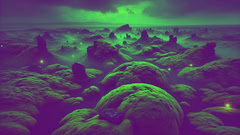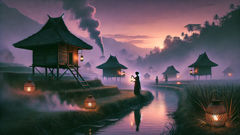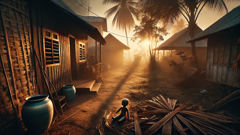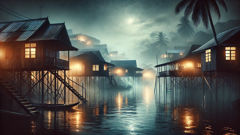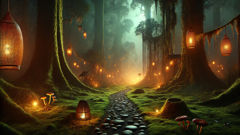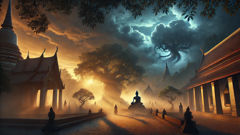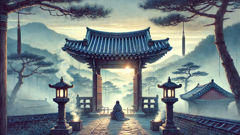Introduction
In a land where daylight clings stubbornly to the horizon all summer, and winter’s darkness is brightened by auroras that skip like ribbons across the sky, Iceland remains a place where old stories are never far from the surface. Here, steaming vents dot emerald valleys, and crags of black lava jut among carpets of ancient, spongey moss—velvet-green, centuries-old, as tender and resilient as the people who walk above. Though wireless signals and rumbling four-wheelers now link the far-off villages, locals still tell tales of the hidden folk: elves—huldufólk—small people who live beneath stones and mounds, whose world is interwoven with the realms of humans but whose patience for disruption is thin as a frost-laced window. In these modern days, when roads snake further and farther, and developers hunger for more efficient paths, the old wisdom is often tested: the moss, elders remind, is sacred, and to disturb elf-hills is to court mischief and disaster. Beneath Iceland’s open skies, a new road-building crew, eager and dismissive, prepares to cross a field where moss has lived undisturbed since the age of sagas. Unbeknownst to them, the huldufólk are watching, their luminous eyes bright with worry—and a little mischief of their own.
Trouble Brews on the Moss Fields
The project began with so much promise, sketched in an office in Reykjavik, far from the soft wildness of the moss fields. The investment had been pitched as a triumph of progress—the new Ring Road bypass, a shorter, faster route for goods and travelers eager to make the loop around the island. Contractors, engineers, and an eager surveyor named Sæmundur arrived at the edge of the highlands, plans rolled under arms, neon vests a jarring contrast to the subtle green and silver world stretching before them. Machinery rumbled, restless as a horse before a storm, while work crewmembers joked about elf tales, pretending bravado while old Þóra, their local guide, pursed her lips silent but worried.
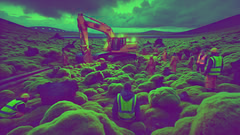
The first days of work went smoothly. Stakes were hammered, survey tape unfurled, and measuring rods poked deep into the loamy ground. One morning, as the sun slipped across the horizon in a long, slow arc, a foreman’s grumbling set the tone: “This moss is nonsense—it’s just dirt. Who keeps worrying about elves?” None answered, but several crewed suppressed shudders and spent an extra moment studying the stone mounds dotting the landscape—round, shadowy lumps older than any map, said by some to be elf churches and homes. A few workers tied red ribbons on boots or muttered quiet apologies, “If you’re there, we mean no harm.”
The first accident seemed pure bad luck. A backhoe, brand new, halted mid-dig just as it reached the largest mossy boulder—a cough of gears and a silence heavy as snowfall. No amount of coaxing or cursing fixed it, until finally, by torchlight, they towed it away. That night, the generator shorted, plunging the campsite into darkness. Sæmundur, lying in his tent, swore shadows flitted by, accompanied by soft, teasing laughter and tiny lights like fireflies. Unnerved, he rose to see if anyone else was awake, only to find the food stores mysteriously upturned, oatmeal scattered and footprints—tiny, narrow, and many-toed—trailing off toward the stones. No animal he knew of left marks like those. The generator, miraculously, worked perfectly at dawn, and no missing tools could be found.
Still, the crew pressed forward, their timetable tight and their anxiety growing. At every disturbance—moss torn, stones moved—some new trouble arose: a sudden hailstorm battered the site at noon; a fuel tank inexplicably ruptured, flooding the ground and forcing a pause; a thick, impossibly persistent fog materialized out of blue sky and lingered for hours. Þóra confronted Sæmundur quietly one afternoon, as he lingered by a particularly lush hill. “You must not cross there,” she warned. “This hill is called Álfhóll—Elf Hill. If you build across it, nothing good will come. My grandmother said only fools ignore the hidden folk.” Sæmundur, spirits wavering but pressure building from Reykjavík, only nodded.
Warnings, Wonders, and Exile
The misfortunes multiplied, turning the project from hopeful to haunted. Determined to hit milestones, Sæmundur authorized a detour through a low, seemingly harmless stretch of moss. The detour bypassed “elf hills” but brought them up against a patchwork of bog and hollow, where the ground trembled underfoot. No marker or ribbon could steady the crew’s nerves. Night after night, equipment glitched, maps faded inexplicably, and the only radio station playing was a haunting chime of bells even experts could not explain. Most unsettling of all, one worker—a practical joker—vanished for several hours and returned shivering, eyes wide, memories scrambled. He whispered of being lost underground, following chimes and laughter, glimpsing “men and women moon-bright, with moss hair and eyes like dew.”
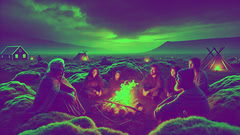
The story whipped through camp, and disbelief cracked. Þóra gathered the youngest workers by the fire, spinning tales of the huldufólk: beings of every shape and mood, guardians of ancient stones, stewards of moss and river, sometimes generous, often fickle. “If you harm their homes, they hide your luck—your tools, your courage,” she finished. Sæmundur, his skepticism threadbare, took her words to heart. Under pressure from headquarters, with a rising unease blooming like a bruise, he called a meeting. The crew—grimy, tired, spooked—debated superstitions versus duty. The tide turned when the cook, usually playful, produced a dried-out bread loaf with a perfect footprint pressed into the crumb: tiny, five-toed, unmistakably not human. Letters to headquarters went unanswered; every time, files corrupted or phones lost signal, as if the very air conspired against them.
Accepting defeat, Sæmundur agreed to halt work until an alternative could be found. The news was met with exhausted relief by some, but an uneasy defiance by investors in Reykjavík, who soon arrived by helicopter, glossy shoes covered quickly by rain-soaked earth. They demanded answers. That night, storms raged beyond all expectation: wind howled, tents torn, machinery tossed as if by giant hands. In the morning, the site was a wreck—the only untouched area the mossy hills, immaculate and green, strange sparkles in the air above them.
Reykjavík’s patience ran out. Local authorities, swayed by press, folklore, and the mounting evidence, intervened. A government mediator, herself from the Westfjords, was dispatched, and on arrival, she listened gravely to Þóra and inspected the site. That evening, as mist curled in, she announced a halt on all roadworks and a plan for new environmental protections. Construction was exiled for good from the moss fields; the Ring Road would detour along older rock paths, as respectful as possible. The mediator signed the order atop the largest elf-stone, hammering her pen thrice—each act met with a curious breeze and a hush, as if the land itself approved.
Respect Restored and the Secret Celebration
In wake of official resignation, the land slowly healed. The heavy scars from diggers and drills faded beneath new grasses and resilient moss. The project’s abandoned site became locally infamous, drawing folklorists, botanists, and curious travelers intrigued by tales of elf mischief and the fierce power of Iceland’s natural world. Media painted the story in hues of mystery and warning, and local children dared each other to explore near (but never on) the abandoned works, always leaving small gifts—a pebble, a flower—near the biggest stones.
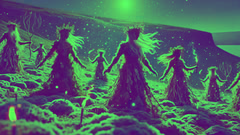
For Sæmundur, the lesson lingered daily. He stayed on, taking work with ecological surveyors, and grew into a quiet steward of the land, ensuring human plans bent around what was old and sacred, not the other way around. Þóra, proud but humble, became somewhat of a legend herself, consulted whenever a new project eyed untamed ground. She always insisted on walking proposed paths first, listening for that flicker of movement at the edge of vision, for the cool hush that marked a place claimed by the huldufólk.
One midsummer’s night, when the sun hovered low but never vanished, a secret gathering unfolded atop the hills. Among the moss, invisible to ordinary folk, figures with crowns of lichen and gowns stitched from birch leaves danced in jubilation. Silver laughter rang; small fires drifted blue in the dusk. The elves, proud guardians, celebrated this hard-won truce. Their queen sang, her voice clear and sweet as meltwater, weaving a blessing for the humans who had listened and for the moss that would survive another age unspoiled. Far off, Sæmundur heard music in his sleep and woke with a lightness in his soul, as if forgiven for thoughtless trespass. That dawn, dew on every stone glinted a little brighter, and a new respect for mysteries both spoken and unspoken settled over the highlands. From then on, when travelers passed the moss fields, they said thank you to the hidden folk, and the land, in turn, watched over them well—so long as respect ran both ways.
Conclusion
Even today, as Iceland balances modernity with tradition, stories of the hidden folk endure, passed down beside hearths and whispered among wind-bent stones. The moss fields remain, lush and unscarred, living proof that beneath every landscape there is a deeper story—a call for respect, humility, and wonder at the world’s quiet power. Thanks to the elves, humanity’s unchecked ambition was checked; a new reverence for nature flourished. Construction projects may succeed or fail, but living alongside the unseen, in harmony with the green, this is the lesson Iceland guards. And if ever another builder forgets, the stones and moss, and perhaps a mischievous breeze, lie ready to remind them: all things have their keepers, and magic, old as the island itself, sometimes rises to defend what it loves most.

